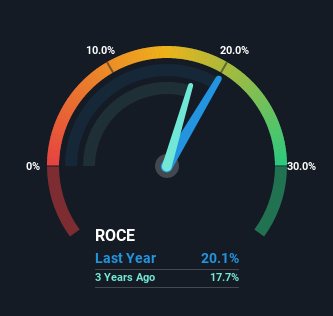A Look Into HEXPOL's (STO:HPOL B) Impressive Returns On Capital

There are a few key trends to look for if we want to identify the next multi-bagger. Firstly, we'll want to see a proven return on capital employed (ROCE) that is increasing, and secondly, an expanding base of capital employed. This shows us that it's a compounding machine, able to continually reinvest its earnings back into the business and generate higher returns. That's why when we briefly looked at HEXPOL's (STO:HPOL B) ROCE trend, we were very happy with what we saw.
Understanding Return On Capital Employed (ROCE)
For those that aren't sure what ROCE is, it measures the amount of pre-tax profits a company can generate from the capital employed in its business. Analysts use this formula to calculate it for HEXPOL:
Return on Capital Employed = Earnings Before Interest and Tax (EBIT) ÷ (Total Assets - Current Liabilities)
0.20 = kr3.3b ÷ (kr22b - kr6.1b) (Based on the trailing twelve months to June 2022).
Thus, HEXPOL has an ROCE of 20%. That's a fantastic return and not only that, it outpaces the average of 6.5% earned by companies in a similar industry.
View our latest analysis for HEXPOL

Above you can see how the current ROCE for HEXPOL compares to its prior returns on capital, but there's only so much you can tell from the past. If you're interested, you can view the analysts predictions in our free report on analyst forecasts for the company.
What The Trend Of ROCE Can Tell Us
In terms of HEXPOL's history of ROCE, it's quite impressive. Over the past five years, ROCE has remained relatively flat at around 20% and the business has deployed 97% more capital into its operations. With returns that high, it's great that the business can continually reinvest its money at such appealing rates of return. If HEXPOL can keep this up, we'd be very optimistic about its future.
Our Take On HEXPOL's ROCE
In summary, we're delighted to see that HEXPOL has been compounding returns by reinvesting at consistently high rates of return, as these are common traits of a multi-bagger. In light of this, the stock has only gained 34% over the last five years for shareholders who have owned the stock in this period. So because of the trends we're seeing, we'd recommend looking further into this stock to see if it has the makings of a multi-bagger.
Before jumping to any conclusions though, we need to know what value we're getting for the current share price. That's where you can check out our FREE intrinsic value estimation that compares the share price and estimated value.
If you'd like to see other companies earning high returns, check out our free list of companies earning high returns with solid balance sheets here.
Valuation is complex, but we're here to simplify it.
Discover if HEXPOL might be undervalued or overvalued with our detailed analysis, featuring fair value estimates, potential risks, dividends, insider trades, and its financial condition.
Access Free AnalysisHave feedback on this article? Concerned about the content? Get in touch with us directly. Alternatively, email editorial-team (at) simplywallst.com.
This article by Simply Wall St is general in nature. We provide commentary based on historical data and analyst forecasts only using an unbiased methodology and our articles are not intended to be financial advice. It does not constitute a recommendation to buy or sell any stock, and does not take account of your objectives, or your financial situation. We aim to bring you long-term focused analysis driven by fundamental data. Note that our analysis may not factor in the latest price-sensitive company announcements or qualitative material. Simply Wall St has no position in any stocks mentioned.
About OM:HPOL B
HEXPOL
Develops, manufactures, and sells various polymer compounds and engineered gaskets, seals, and wheels in Sweden, rest of Europe, the United States, rest of the Americas, and Asia.
Very undervalued 6 star dividend payer.
Similar Companies
Market Insights
Community Narratives



